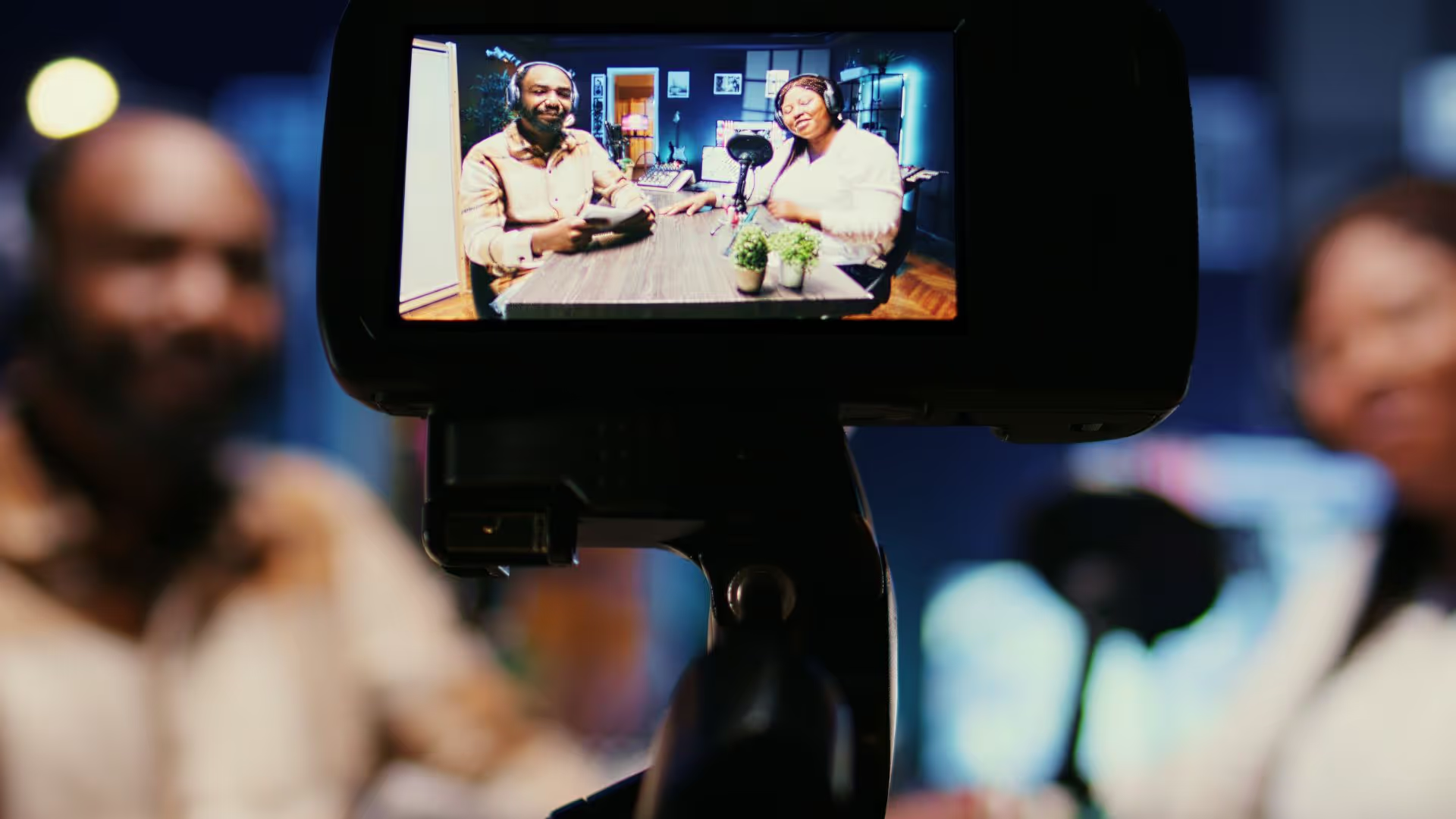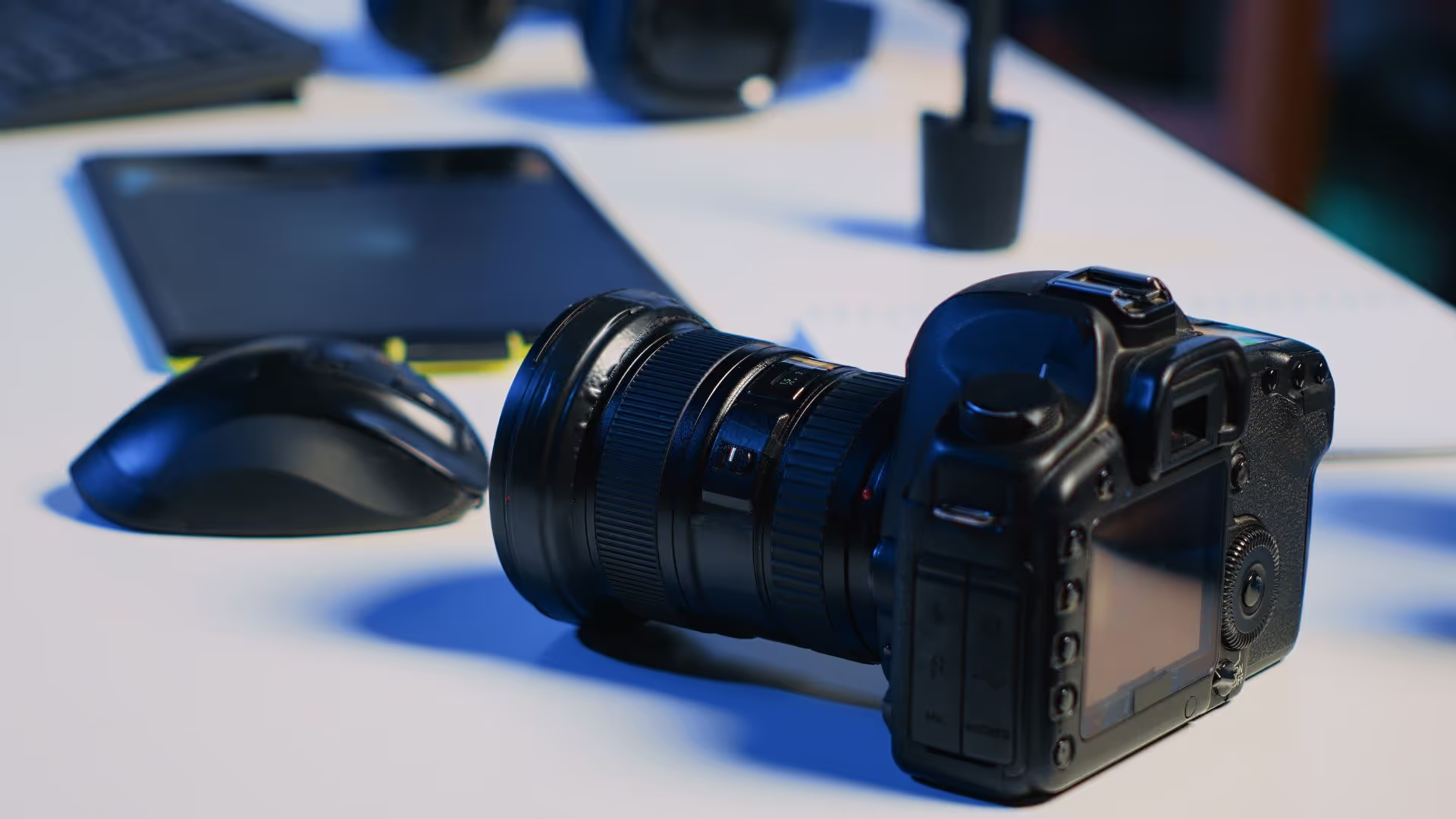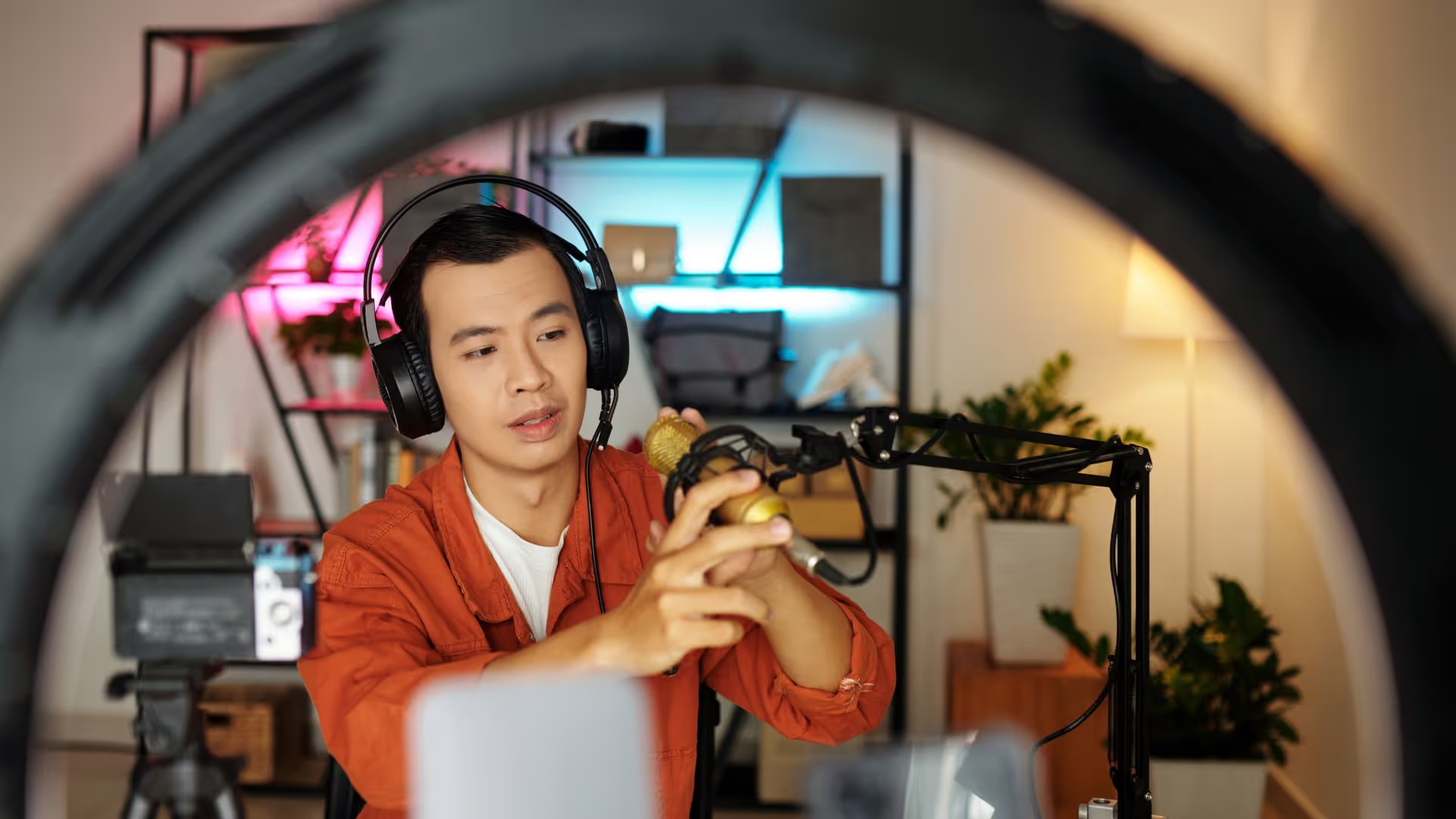
Let's Talk
Menu

Podcasting has come a long way from being audio-only. It’s all about the visuals now. And if you want your show to grow, engage, and connect with your audience, it’s time to consider stepping into frame.
That’s where Cue comes in, offering expert support for video podcast production, from filming and editing to marketing. Cue helps podcasters bring their shows to life on screen, making it easier than ever to connect with viewers and expand your reach.
On that note, it’s National Camera Day! To celebrate, we sat down with Rowan Walsh, one of Cue’s Podcast Video Producers, to get his insights on why video is so crucial for podcasters, its undeniable advantages, and what challenges creators might face.
Let’s get into it.
"Most of the content we take in now is visual", Rowan says. "You're watching stuff constantly: TikToks, YouTube, [Instagram] Reels. So when someone finds a podcast, they almost expect to see it too. If you're not doing video, you're basically shutting the door on half your potential audience".
But it’s not just about pointing a camera at yourself.
"It’s about making the experience feel more real", he explains. "You see someone’s face when they’re telling a story, or how two co-hosts bounce off each other. That kind of stuff doesn’t always come through in audio. Video gives people another way to connect with what you’re saying".
Video adds a whole new dimension to podcasting by bringing your show to life in ways audio alone can’t. Rowan shares some of the main benefits that video offers, from helping you connect with your audience to opening up new possibilities for growth:
“Honestly, one of the best things is just how much closer it makes you feel to the person talking”, he says. “Seeing someone’s face makes it feel like you’re having a proper chat with a mate; not just listening to a voice on the radio. That’s how you build trust and get people coming back”.
“It’s not just about planting yourself in front of a camera”, Rowan adds. “You’ve got to think visually from the get-go: how do you make the conversation more interesting? Can you throw in some B-roll? Would some graphics help explain what you’re saying? Those are the kind of things we focus on to take a video from just alright to really good”.

While the benefits are clear, Rowan is quick to point out that video podcasting isn't without its challenges. “It’s a different skillset and usually needs more resources than just audio”, he says.
“The main thing is don’t let it scare you”, Rowan finishes. “Start small, try things out and add more video bits as you get confident. The payoff in audience growth and engagement is definitely worth it”.
“I’d say it’s because people naturally want to connect on a deeper level. It’s like, if you’re just listening to a voice, it’s one thing, but seeing someone’s expressions or body language adds so much more. It’s not just about showing up on camera; it’s about making that connection feel real. Plus, with so much video content everywhere these days, people are used to seeing what they’re consuming, so podcasting is catching up”.
“Not at all. If audio works for your show and your audience, stick with it. But if you’ve got the time and the interest, adding video can bring a whole new energy. It helps people connect with you more, and you’ve got more options when it comes to promotion. That said, it adds a layer of work too. Editing, lighting, framing, all stuff you don’t worry about with just audio. So it’s about what fits your workflow. If it feels like a chore, it’ll show”.
“The best camera is the one you use. People say this all the time, but it’s true. A cheap camera you enjoy and feel comfortable using will be better than a super expensive one you don’t understand. Because of that, I tend to stick with Sony cameras, like my Sony A7 III for photography, and the Lumix GH5 for video, as I’ve grown my skills using them. I know there are better options out there, and I know I could upgrade to the Sony A7 IIII, for example, but it’d be an unnecessary purchase. Camera marketing and reviews will always suggest you need the new model, but in reality cameras got really good in the 2010s, and most modern DSLRs are really good”.
“Honestly, the camera sets the technical base but it’s how you use it that counts. A nicer camera lets you play with focus and colour to create a certain mood, which can really elevate the storytelling. But it’s not about having the fanciest gear; it’s about using what you have to tell your story visually. Sometimes it’s better to know your equipment inside out than to have the newest model and not use it well”.
“Honestly, I just think about what would feel natural to watch. What would keep me engaged if I was the viewer? That could be switching up angles, showing little bits of behind-the-scenes, or using B-roll to add some energy. It’s more about feel than perfection. You don’t need a storyboard, just a rough idea of the vibe you’re going for. I usually plan for a few wide and close shots, and I try to make the space look clean and lived-in without being distracting. It’s more about building atmosphere than creating a polished set”.
“Keep it simple. You don’t need a full studio setup to make it look good. Natural light is your friend. If I’m shooting during the day, I’ll always try to work near a window so I’m getting soft, even light across my face. If that’s not an option, one softbox or even a cheap ring light can do the trick. The goal’s just to make sure your face is well lit and not full of shadows. You don’t need to overthink it, but you do need to avoid looking like you’re sitting in a dark cave. A bit of effort goes a long way”.
“I keep my workflow tight. Reusing templates, presets, anything that saves time. I’ll batch edit when I can, so I’m not stopping and starting every time. And honestly, I try not to obsess over every tiny detail. Good enough and out there is better than perfect and unfinished. If you’re tweaking things for hours that no one will notice, you’re just burning time. I’d rather have three good videos live than one ‘perfect’ one sitting on a hard drive”.
“Overcomplicating it. People think they need a full studio setup on day one, but that can actually slow you down or put you off. I’ve seen people spend more time messing with gear than actually recording anything. It’s way better to keep it simple, especially at the start. Use gear you know. Focus on clear audio, decent lighting, and not having a cluttered background. Once you’ve got that locked in, then you can think about fancy extras. Don’t let the tech get in the way of the content”.
“Yeah, stop trying to ‘perform’. Just talk like you would to a mate. A lot of people freeze up because they’re too focused on sounding professional or polished. But audiences connect with real people. Take a breath, shake out your nerves, and just chat. If you mess up, who cares? You can edit it or leave it in, and honestly, leaving it in makes it feel more human. The more you do it, the easier it gets, and eventually the camera just becomes background noise”.
“Don’t overthink it. It’s easy to get caught up in trying to make everything perfect, but that can kill the natural vibe. Start with what you’ve got and focus on being yourself on camera. Think about lighting and sound because those really make a difference. Also, don’t be scared to make mistakes and learn as you go. Every shoot teaches you something new. The more comfortable you get, the better your videos will feel”.

Video has become a non-negotiable part of podcasting: it grabs attention, builds trust, and opens the door to massive distribution across YouTube, TikTok, Instagram, and more. If you want your show to grow, connect, and convert, video needs to be part of the plan.
But creating a high-quality video podcast isn’t easy; especially if you’re trying to do everything yourself. From planning and scripting, to filming, editing, and promotion, the workload adds up fast. Most people underestimate what’s involved until it becomes overwhelming.
That’s why we built Cue.
We handle the entire podcasting process from start to finish: concept development, guest sourcing, video production, publishing, marketing, and performance reporting. Our team becomes your team: making your podcast look, sound, and feel world-class. We handle everything:
We work with everyone from solo creators to global brands across industries like tech, healthcare, education, media, and more. Whether you need a polished interview series or a documentary-style narrative show, we make it happen. All you have to do is show up; we take care of the rest.
Ready to get behind the camera? Just remember, video podcasting isn’t only about the tech or the setup. It’s about telling your story in a way that keeps people watching and listening.
Rowan stresses that success comes from creativity, consistency, and having a clear vision. It’s about making content that feels authentic to you and resonates with your audience. Don’t be afraid to experiment and find what works best for your style and message.
At the end of the day, the camera is just a tool. Your story is what truly matters. As Rowan puts it, “Great video podcasts aren’t about perfection; they’re about connection. If you can connect, you’ve already won.”
Want to see how video can take your show to the next level? Explore Cue’s podcast video production services or get in touch today.
Let’s get your show camera-ready.

Join our carefully curated newsletter packed with insights, tips and resources to help shape and share your stories.